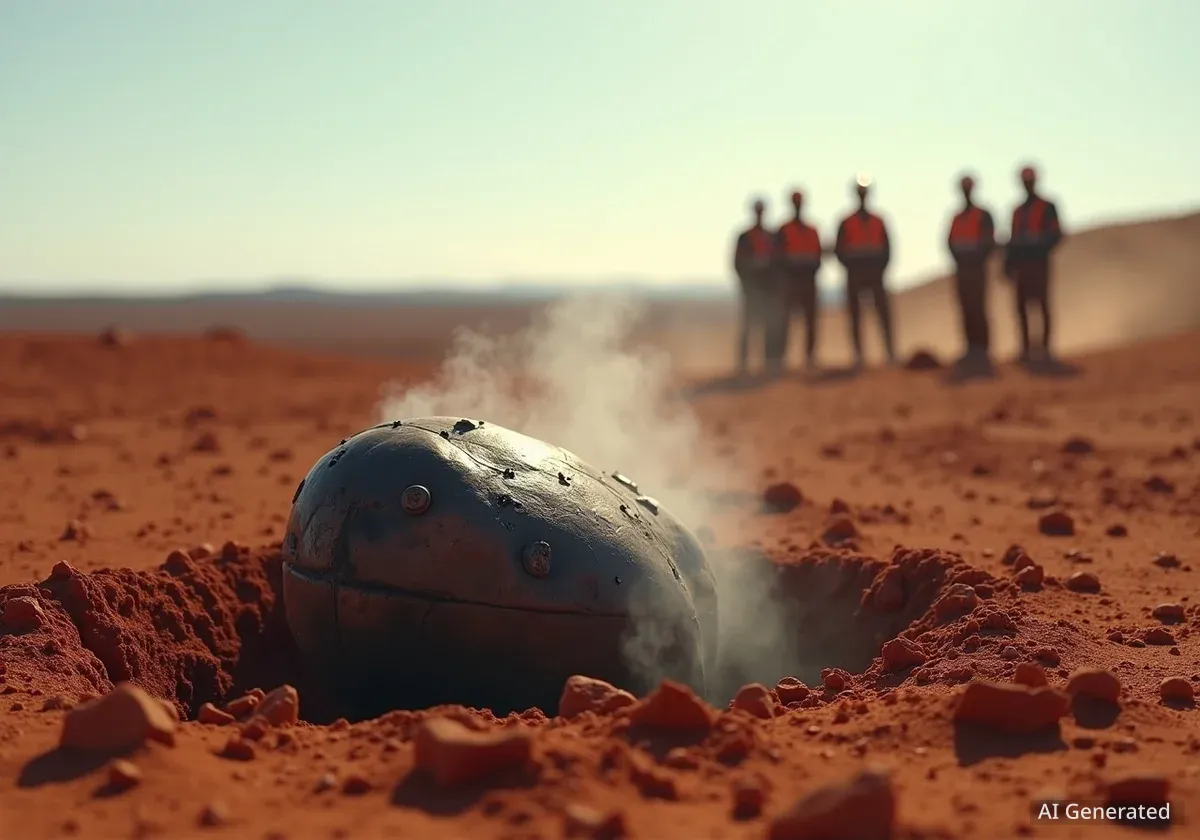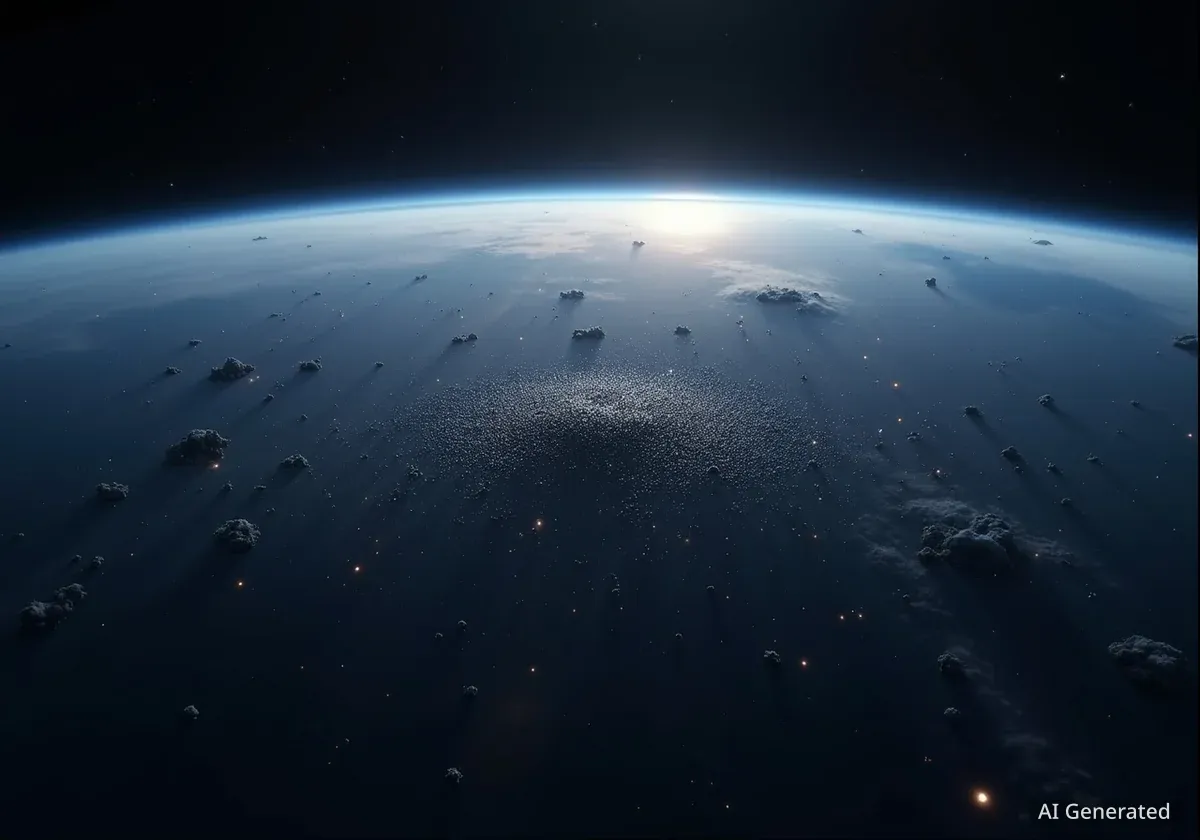An investigation is underway in Western Australia after mine workers discovered a large, burning object in the remote Pilbara region. Authorities have confirmed the object is consistent with space debris, raising questions about its origin and the unexpected nature of its re-entry into Earth's atmosphere.
The discovery was made on Saturday, October 18, around 2 p.m. local time, prompting an immediate call to emergency services. The Australian Space Agency is now leading a technical assessment to determine the object's source.
Key Takeaways
- A burning object discovered by mine workers in Pilbara, Western Australia, has been identified as probable space debris.
- West Australia police stated the object's characteristics are consistent with a "composite-overwrapped pressure vessel or rocket tank."
- Experts suggest the debris could be from the fourth stage of a Chinese Jielong rocket launched in late September.
- The re-entry of this specific piece was reportedly unpredicted, highlighting challenges in tracking orbital debris.
An Unexpected Discovery in the Outback
Workers at a remote mine site in the Pilbara region of Western Australia encountered an unusual scene on Saturday afternoon. A large, metallic object was found actively burning in the outback, far from any known crash sites. Emergency services were dispatched to the location to assess the situation.
Upon arrival, first responders secured the area. Initial assessments quickly ruled out a commercial aircraft incident. West Australia police released a statement describing the object as a possible "composite-overwrapped pressure vessel or rocket tank," a component commonly used in aerospace applications.
The police confirmed that the burning object has been secured and poses no immediate threat to the public. The investigation has been handed over to specialists to conduct a more detailed analysis.
What is Space Debris?
Space debris, often called space junk, includes any man-made object orbiting Earth that no longer serves a useful purpose. This can range from spent rocket stages and defunct satellites to fragments from explosions or collisions. Most of this debris burns up completely upon re-entering the atmosphere, but larger pieces can survive and reach the ground.
Official Response and Investigation
The Australian Space Agency is now spearheading the effort to identify the debris. In a formal statement, West Australia police noted that the investigation is ongoing.
"The object remains under investigation, though its characteristics are consistent with known space re-entry debris," the police statement read. "Further technical assessment will be undertaken by engineers from the Australian Space Agency to assist in identifying its nature and source."
This technical assessment will involve analyzing the materials and construction of the object to match it with known spacecraft or launch vehicles. Such investigations are crucial for verifying which country or company is responsible for the object, which is a key part of international space law.
A Common but Unpredictable Occurrence
While it is not uncommon for rocket components to be intentionally deorbited, the circumstances of this event are notable. Matt Woods of the Perth Observatory explained that parts of rocket bodies are often designed to re-enter the atmosphere. However, he noted, "it could just be the way that it's been tumbling that this piece was able to survive."
The survival of such a large fragment highlights the unpredictable nature of atmospheric re-entry, where factors like angle, speed, and object composition determine how much material reaches the surface.
Tracing the Debris: A Possible Chinese Rocket
While official identification is pending, some experts have already proposed a likely origin for the mysterious object. Dr. Alice Gorman, a space archaeologist and associate professor at Flinders University, has suggested the debris may belong to a Chinese rocket.
"It seems to be the fourth stage of a Jielong rocket," Dr. Gorman stated, pointing to a specific launch that occurred recently. "There was one launched in late September. If it is the one from the 25th, that means it’s been orbiting the Earth for a bit and then came out of the blue."
What makes this re-entry particularly interesting is the lack of warning. According to Dr. Gorman, there were no public predictions for this object's re-entry, which is unusual for larger pieces of space junk that are typically tracked.
"When I went to look for re-entry predictions I couldn’t find anything, which is an indication of the suddenness of it."
This suggests the object's orbital decay happened more rapidly or unpredictably than expected, a scenario that complicates efforts to provide advance warnings for potential ground impact zones.
Earth's Crowded Orbit
According to the European Space Agency (ESA), there are more than 36,500 pieces of space debris larger than 10 cm currently being tracked in orbit. The total mass of all man-made objects in Earth's orbit is estimated to be over 11,000 tonnes. While impacts on populated areas are rare, the sheer volume of debris poses a significant risk to active satellites and future space missions.
The Growing Problem of Space Junk
This incident in Australia serves as a physical reminder of the growing challenge posed by orbital debris. For decades, countries and private companies have been launching satellites and rockets, leaving behind a trail of non-functional hardware in orbit.
Most of these objects orbit at extremely high velocities, meaning even a small fragment can cause catastrophic damage to an operational satellite or spacecraft. As the space around our planet becomes more congested, the risk of collisions increases, which in turn can create even more debris in a chain reaction known as the Kessler syndrome.
International Efforts and Responsibilities
Several international agreements, including the Outer Space Treaty, outline the responsibilities of nations for the objects they launch into space. This includes liability for any damage caused by their space objects falling back to Earth.
Key points regarding space debris management include:
- Tracking and Monitoring: Space surveillance networks around the world track thousands of the largest objects to predict their orbits and potential collisions.
- Mitigation Guidelines: International guidelines recommend that new satellites be designed to deorbit themselves within 25 years of mission completion.
- Active Debris Removal: Companies and agencies are developing new technologies, such as robotic arms and nets, to actively capture and remove existing large pieces of debris from orbit.
The discovery in Pilbara underscores the importance of these efforts. While the Australian outback is sparsely populated, reducing the risk of such objects falling in denser urban areas is a priority for the global space community. The final report from the Australian Space Agency will be crucial in confirming the object's origin and adding another data point to the complex issue of managing our planet's orbital environment.




